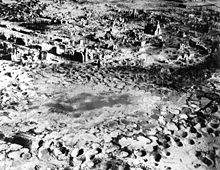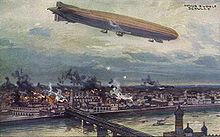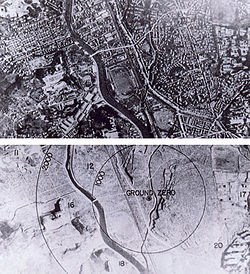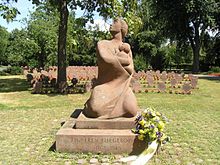Aerial bombing of cities - Picture
More about World War 1

|
|
Aerial bombing of cities

Picture - The remains of German town of Wesel after intensive allied area bombing in 1945 (destruction rate 97% of all buildings)
A species of strategic bombing, the aerial bombing of cities began in 1915 during World War I, grew to a vast scale in World War II, and continues to the present day.
Aerial bombing of cities before World War II
First Italian War of Independence
The first bombs delivered to their targets by air were launched on unmanned balloons, carrying a single bomb, by the Austrians against Venice in 1849, during the First Italian War of Independence.
Balkan War
Adrianople (presently Edirne) was bombed by Bulgaria in 1912 in the First Balkan War. Historically, it was the first bombardment from a heavier-than-air craft.
Mexican Revolution
In May 1914, during the revolution of 1910-17 General Venustiano Carranza, later president, intent on taking the city of Mazatlx¡n, ordered a biplane to bomb Neveria Hill adjacent to the downtown area of Mazatlx¡n. The bomb landed not on target but in a city street and in the process killed two citizens and wounding several others.
World War I

Picture - German airship Schutte Lanz SL2 bombing Warsaw in 1914.
One of the first aerial bombardments of civilians during World War I was on 19 January 1915, in which two German Zeppelins dropped 24 fifty-kilogram high-explosive bombs and ineffective three-kilogram incendiaries on the English towns of Great Yarmouth, Sheringham, King's Lynn, and the surrounding villages; in all, four people were killed, 16 injured, and monetary damage was estimated at £7,740, although the public and media reaction would today be considered out of proportion to the death toll.
London was bombed in May and in July 1916, the Kaiser allowed directed raids against urban centers, sparking 23 airship raids in 1916 in which 125 tons of ordnance were dropped, killing 293 people and injuring 691. Gradually British air defenses improved and the Germans also introduced large bomber aircraft for bombing Britain. In 1917 and 1918 there were only eleven Zeppelin raids against England, and the final raid occurred on 5 August 1918, which resulted in the death of KK Peter Strasser, commander of the German Naval Airship Department. By the end of the war, 51 raids had been undertaken, in which 5,806 bombs were dropped, killing 557 people and injuring 1,358. In the course of the Zeppelin raids the Germans lost more than half their airships and 40% of their crew. It has been argued that the raids were effective far beyond material damage inflicted, in diverting and hampering wartime production, and diverting twelve squadrons and over 10,000 men to air defenses.
The British developed an Independent Force of long range bombers that could bomb Berlin but the war ended before these raids began.
After the war, bombers' increasing sophistication led to the general belief that aerial bombing would both destroy cities and be impossible to stop; as Stanley Baldwin stated in a 1932 speech, "The bomber will always get through".
Second Italo-Abyssinian War
The Italians used aircraft against the Ethiopian cities in the Second Italo-Abyssinian War. For example, in February 1936, the Italian invasion forces in the south prepared for a major thrust towards the city of Harar. On 22 March, the Regia Aeronautica bombed Harar and Jijiga as a prelude. Both cities were reduced to ruins even though Harar had been declared an "open city".
Spanish Civil War
During the Spanish Civil War, the Nationalists under Francisco Franco made extensive use of aerial bombing on civilian targets. Nazi Germany gave aircraft to Franco to support the overthrow of the Spanish Republican government. The first major example of this came in November 1936, when German and Spanish aircraft bombed Republican held Madrid; this bombardment was sustained throughout the Siege of Madrid. Barcelona and Valencia were also targeted in this way. On 26 April 1937, the German Luftwaffe (Condor Legion) bombed the Spanish city of Guernica carrying out the most high profile aerial attack of the war. This act caused worldwide revulsion and was the subject of a famous painting by Picasso, but by the standards of bombings during World War II, casualties were fairly minor (estimates ranging from 500 to 1,500); however, it remains significant as it was the first-ever saturation bombing of a civilian population.
Shortly after, the front page headlines of the Diario de Almeria, dated June 3, 1937, referred to the press in London and Paris carrying the news of the "criminal bombardment of Almeria by German planes".
Barcelona was bombarded for three days beginning on 16 March 1938, at the height of the Spanish Civil War. Under the command of the Italian dictator Benito Mussolini, Italian aircraft stationed on the island of Majorca attacked 13 times dropping 44 tons of bombs, aimed at the civil population. These attacks were at the request of General Franco as retribution against the Catalan population. The medieval Cathedral of Barcelona suffered bomb damage and more than one thousand people died, including many children. The number of people injured is estimated to be in the thousands.
Second Sino-Japanese War
![World War 1 Picture - Casualties of a mass panic during a Japanese air raid in Chongqing[citation needed]](images/1-images6111/170px-Casualties_of_a_mass_panic_-_Chungking2C_China.jpg)
Picture - Casualties of a mass panic during a Japanese air raid in Chongqing[citation needed]
During the Manchurian Incident of 1931, the Japanese widely used airplanes to indiscriminately bomb key targets and cities, such as Mukden. After the Marco Polo Bridge Incident, the Imperial Japanese Army Air Service, in conjunction with the Imperial Japanese Navy Air Service, began relentlessly bombing Shanghai, Beijing, Tianjin and several cities on the Chinese coast from the beginning of the Second Sino-Japanese War in 1937.
The bombing campaigns on Nanking and Guangzhou which started in September 1937 evoked protests from the Western powers culminating in a resolution by the Far Eastern Advisory Committee of the League of Nations. An example of the many expressions of indignation came from Lord Cranborne, the British Under-Secretary of State For Foreign Affairs:
Words cannot express the feelings of profound horror with which the news of these raids had been received by the whole civilized world. They are often directed against places far from the actual area of hostilities. The military objective, where it exists, seems to take a completely second place. The main object seems to be to inspire terror by the indiscriminate slaughter of civilians...
Words cannot express the feelings of profound horror with which the news of these raids had been received by the whole civilized world. They are often directed against places far from the actual area of hostilities. The military objective, where it exists, seems to take a completely second place. The main object seems to be to inspire terror by the indiscriminate slaughter of civilians...
Aerial bombing during World War II
European theater
At the beginning of World War II, bombing of cities prior to invasion was an integral part of Nazi Germany's Blitzkrieg concept. In the first stages of war, the Germans carried out many bombings of towns and cities in Poland (1939), including the capital Warsaw (also bombed in 1944), with Wieluń being the first city destroyed by 75%. Soviet Union also attempted strategic bombing against Finland, bombing Helsinki.
Similar tactics were also used by the Germans during the Rotterdam Blitz in 1940. While Germany refrained from aerial bombing of British cities after the British declaration of war on Germany in September 1939, Britain started aerial bombing of Germany, officially focusing on military and industrial targets, on the night of 15/16 May with 78 bombers against oil targets, 9 against steelworks and 9 against marshaling yards. Oil remained the main British objective until the summer of 1941.
After the German victory in the Battle of France, the Luftwaffe turned its attention to the United Kingdom. The scale of the attack increased greatly in July, with 258 civilians killed, and again in August with 1,075 dead. During the night of 28/29 August, British bombers raided targets in and around Greater Berlin for the first time, in response to the bombing of London by the Luftwaffe. On the 7th September the Luftwaffe began massed attacks on London in retaliation. Following Hitler's decision to drop the invasion plans, there was an intensive bombing of cities in the UK, including London and Coventry. The bombing campaign was known in the UK as "the Blitz", and ran from September 1940 through to May 1941 with the goal of forcing the British government to accept peace without the need for an invasion. The Coventry Blitz and the Belfast Blitz were two of the most disastrous of all bombings by the Luftwaffe, killing 568-1,000 civilians of Coventry, killing over 1,100 people in Belfast and destroying much of both city centres.
British bombing policy evolved during the war. In the beginning, the RAF were forbidden to attack targets in Germany due to the risk of accidental civilian casualties. Following a German attack on military targets in the Orkney Islands on 16 March 1940 that killed a civilian, the RAF mounted their first attack against a German land target, the seaplane base on the island of Sylt. The RAF began attacking transport targets west of the Rhine on the night of 10 May following the German invasion of the Low Countries, and military targets in the rest of Germany after the bombing of Rotterdam. On 9 September 1940 RAF crews were instructed that due to the "indiscriminate" nature of German bombing, if they failed to find their assigned targets they were to attack targets of opportunity rather than bring their bombs home. On the 15/16 December the RAF carried out their first area bombing attack on the city (destroying 45% of town Mannheim), in response to the raid on Coventry.
In 1942, the goals of the British attacks were defined: the primary goal was the so called "morale bombing", to weaken the will of the civil population to resist. Following this directive intensive bombing of highly populated city centers and working class quarters started. On 30 May 1942, the RAF Bomber Command launched the first "1,000 bomber raid" when 1,046 aircraft bombed Cologne in Operation Millennium, dropping over 2,000 tons of high explosive and incendiaries on the medieval town and burning it from end to end. 411 civilians and 85 soldiers were killed, more than 130,000 had to leave the city.
Two further 1,000 bomber raids were executed over Essen and Bremen, but to less effect than the destruction at Cologne. The effects of the massive raids using a combination of blockbuster bombs and incendiaries created firestorms in some cites. The most extreme examples were caused by the bombing of Hamburg in Operation Gomorrah (45,000 dead), and the bombings of Kassel (10,000 dead), Darmstadt (12,500 dead), Pforzheim (21,200 dead), Swinemuende (23,000 dead), and Dresden (30,000 dead).
The Allies also bombed urban areas in the other countries, including occupied France (Caen) and the major industrial cities of northern Italy, like Milan and Turin. Some cities were bombed at the different times by the Luftwaffe and the Allies, for example Belgrade in Yugoslavia or Bucharest in Romania.
The Luftwaffe also bombed cities in the Soviet Union, destroying Stalingrad in a massive air raid at the start of the Battle of Stalingrad and bombing Leningrad during the siege of the city of 1941-1943. The Soviet bombing of the German cities was limited in comparison to the RAF bombing (destruction caused by the Soviet army was mainly due to the land artillery). The Soviet Air Force also bombed Budapest in Hungary.
Pacific theater
Further reading: United States strategic bombing of Japan

Picture - Nagasaki before and after bombing
In the Pacific theater, Japan continued to bomb Chinese cities during the Second World War. In the first few months of the war with the Western Powers it projected its airpower on cities as distant as Honolulu, Colombo and Darwin.
The U.S. firebombed Tokyo and killed more than 100,000 in the deadliest conventional bombing in history, while some 250,000 other civilians died in 66 other cities. In a few hours, 100,000 people who were in Tokyo including civilians died either by the bombing or the fire that followed the bombing by 325 US B-29's night attacks. The fleet included 279 bombers. The bombing was meant to burn wooden buildings and indeed the bombing caused fire that created 50 m/s wind that is comparable to tornadoes. Each bomber carried 6 tons of bombs. Total 381,300 bombs which amount to 1783 tons of bombs were used in the bombing. In addition, the atomic bombings of Hiroshima and Nagasaki killed over 200,000 people.
Aerial bombing since World War II
The Cold War (theoretical)
During the Cold War, the threat of destruction of cities by nuclear weapons carried on bombers or ICBMs became the main instrument of the "balance of terror" that allegedly kept the United States and Soviet Union from open warfare with one another. (See mutual assured destruction and RBS "Express".)
Korean War
During the Korean War of 1950-1953, United States and other countries of the United Nations (UN) coalition heavily bombed the cities in North Korea and the North-occupied South Korea, including their respective capital cities. There were also plans to use nuclear weapons against North Korea and the People's Republic of China.
Vietnam War
During the Vietnam War United States from 1965 to 1968 conducted an aerial campaign known as Operation Rolling Thunder. The campaign began with interdiction of supply lines in rural areas of southern North Vietnam but incrementally spread northward throughout the country. In 1966, restrictions against bombing the capital city of Hanoi and the country's largest port, Haiphong were lifted, and they were bombed by the USAF and Navy. The bombing of the city centers continued to be prohibited. However, the South Vietnamese cities seized by the communists were bombed, including the former capital of Huế during the 1968 Tet Offensive.
The Vietnam Air Force bombed contested cities in South Vietnam in 1968, 1972 and 1975, while the Vietnam People's Air Force attacked Southern cities (including the capital city of Saigon) in 1975.
Arab-Israeli conflict
Lebanese capital of Beirut was attacked by the Israeli aircraft during the Siege of Beirut, killing several thousand people in 1982 and during the 2006 Lebanon War (using guided munitions). Israel also conducted air strikes targeting Palestinian targets during the Second Intifada, including against Hamas in Gaza.
War in Afghanistan
In 1979, the Soviets carpet-bombed the Afghan third-largest city of Herat, causing massive destruction and some 5,000 to 25,000 deaths. Herat was also repeatedly bombed during the following Soviet involvement in the Afghan civil war.
Following the September 11, 2001 attacks, the U.S.-led coalition attacked the urban targets in Afghanistan using precision-guided munitions (or "smart bombs"). The United States government maintains that it has a policy of striking only militarily-significant targets while doing all possible to avoid what it terms "collateral damage" to non-military areas and persons.
Iran-Iraq War
Saddam Hussein's Iraq attacked civilian targets in Iranian cities in the "War of the Cities" during the Iran-Iraq War in the 1980s, with Iranians retaliating in kind (both sides soon switched to ballistic missile attacks). Iraqi aircraft also bombed the Iraqi Kurdistan city of Halabja with conventional and chemical weapons in 1988, killing more than 5,000 people in the largest aerial poison gas attack in history.
Gulf War
The Iraqi Air Force attacked Kuwait City in 1990 and bombed their own cities during the 1991 uprisings in Iraq, targeting civilians with the use of bomb-carrying helicopters (use of airplanes was banned by the Coalition).
UN coalition aircraft attacked targets in Iraqi cities, including in capital Baghdad and the largest southern city of Basra.
Yugoslav wars
During the Yugoslav wars, the Yugoslav Air Force attacked cities in Croatia during the Croatian War of Independence in 1991, most notably the besieged city of Vukovar which was destroyed by air strikes and artillery.
In the Kosovo War of 1999, NATO bombed city areas, including the Serbian capital of Belgrade, killing several hundred people in Serbia and Kosovo.
Chechen wars
Post-Soviet Russia heavily bombed the Chechen capital of Grozny from air with mostly unguided munitions (including fuel-air explosives) as well as bombarding it with a massive artillery barrages (1994-1995, 1996 and 1999-2000), killing thousands of people (some estimates say 27,000 civilians were killed during the 1994-1995 siege alone) during the First and Second Chechen Wars. In 2003, the UN still called Grozny the most destroyed city on earth.
Iraq War
In 2003 Invasion of Iraq, the U.S.-led coalition again bombed Iraq, including the Shock and Awe campaign of precision bombing of government targets in the city centers. Since then, coalition aircraft attack Iraqi insurgent targets, including in urban locations like Najaf, Fallujah, Basra and Baghdad. There are frequent reports of civilian casualties, though it is often hard to distinguish guerrillas and civilians. According to Iraq Body Count, thousands of civilians have been killed by aerial bombardment in the Iraq War, the majority during the invasion.
Other conflicts
Budapest was attacked by the Soviet air strikes in 1956 during the Hungarian Revolution. In 2008, the cities of Tskhinvali and Gori were hit by the Georgian and Russian aircraft during the war in Georgia.
Aerial bombardment and international law

Picture - A memorial for victims of aerial bombing in Karlsruhe, Germany
Air warfare must comply with laws and customs of war, including international humanitarian law by protecting the victims of the conflict and refraining from attacks on protected persons.
These restraints on aerial warfare are covered by the general laws of war, because unlike war on land and at sea-which are specifically covered by rules such as the Hague Regulations and Protocol I additional to the Geneva Conventions, which contain pertinent restrictions, prohibitions and guidelines,- there are no treaties specific to aerial warfare.
To be legal aerial operations must comply with the principles of humanitarian law: military necessity, distinction, and proportionality: An attack or action must be intended to help in the military defeat of the enemy, it must be an attack on a military objective, and the harm caused to civilians or civilian property must be proportional and not excessive in relation to the concrete and direct military advantage anticipated.
Hague Conventions, addressing the codes of wartime conduct on land and at sea, were adopted before the rise of air power. Despite repeated diplomatic attempts to update international humanitarian law to include aerial warfare, it was not updated before the outbreak of World War II. The absence of positive international humanitarian law does not mean that the laws of war did not cover aerial warfare, but there was no general agreement of how to interpret those laws for the period up until the end of world War II.
Aerial bombardment and international law
Area bombardment
Bombing of Wieluń
Carpet bombing
Civilian casualties of strategic bombing
Guernica (painting)
Roerich Pact
Strategic bombing
Strategic bombing survey
Tactical nuclear weapon
Terror bombing
Aerial defence of the United Kingdom · United States Army Air Forces (USAAF) · List of Battle of Europe air operations · Defense of the Reich
Francisco Javier Guisx¡ndez Gx³mez, a colonel in the Spanish Air Force ICRC: "The Law of Air Warfare" International Review of the Red Cross no 323, p. 347-363
Jefferson D. Reynolds. "Collateral Damage on the 21st century battlefield: Enemy exploitation of the law of armed conflict, and the struggle for a moral high ground". Air Force Law Review Volume 56, 2005(PDF) pp. 4-108
Charles Rousseau, Le droit des conflits armés, Editions Pedone, Paris, 1983
Further reading
Grayling, A. C. (2006). Among the Dead Cities. New York: Walker Publishing Company Inc.. ISBN 0-8027-1471-4.
Joan T. Phillips. List of documents and web links relating to the law of armed conflict in air and space operations, May 2006. Bibliographer, Muir S. Poochild Research Information Center Maxwell (United States) Air Force Base, Alabama.
Hansen, Randall. Fire and Fury: the Allied Bombing of Germany (Doubleday 2008). ISBN 978-0-385-66403-5 (0-385-66403-6)
More aircraft.
Source: WikiPedia